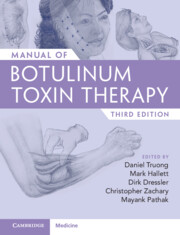59 results
Chapter 4 - Immunological Properties of Botulinum Neurotoxins
-
-
- Book:
- Manual of Botulinum Toxin Therapy
- Published online:
- 02 November 2023
- Print publication:
- 23 November 2023, pp 18-22
-
- Chapter
- Export citation
Contributors
-
- Book:
- Manual of Botulinum Toxin Therapy
- Published online:
- 02 November 2023
- Print publication:
- 23 November 2023, pp ix-xiv
-
- Chapter
- Export citation
Dedication
-
- Book:
- Manual of Botulinum Toxin Therapy
- Published online:
- 02 November 2023
- Print publication:
- 23 November 2023, pp v-vi
-
- Chapter
- Export citation
Index
-
- Book:
- Manual of Botulinum Toxin Therapy
- Published online:
- 02 November 2023
- Print publication:
- 23 November 2023, pp 348-352
-
- Chapter
- Export citation
Copyright page
-
- Book:
- Manual of Botulinum Toxin Therapy
- Published online:
- 02 November 2023
- Print publication:
- 23 November 2023, pp iv-iv
-
- Chapter
- Export citation
Preface for the Third Edition
-
- Book:
- Manual of Botulinum Toxin Therapy
- Published online:
- 02 November 2023
- Print publication:
- 23 November 2023, pp xv-xvi
-
- Chapter
- Export citation
Contents
-
- Book:
- Manual of Botulinum Toxin Therapy
- Published online:
- 02 November 2023
- Print publication:
- 23 November 2023, pp vii-viii
-
- Chapter
- Export citation

Manual of Botulinum Toxin Therapy
-
- Published online:
- 02 November 2023
- Print publication:
- 23 November 2023
Appendix IV: - DystonieNet: A Dutch Approach for Optimising the Treatment of Cervical Dystonia
-
- Book:
- Treatment of Dystonia
- Published online:
- 31 May 2018
- Print publication:
- 07 June 2018, pp 444-445
-
- Chapter
- Export citation
4 - Non-Primary Dystonias
- from Section I - Basics
-
-
- Book:
- Treatment of Dystonia
- Published online:
- 31 May 2018
- Print publication:
- 07 June 2018, pp 20-26
-
- Chapter
- Export citation
Section I - Basics
-
- Book:
- Treatment of Dystonia
- Published online:
- 31 May 2018
- Print publication:
- 07 June 2018, pp 7-96
-
- Chapter
- Export citation
Section VII - Pharmacotherapy for Dystonia
-
- Book:
- Treatment of Dystonia
- Published online:
- 31 May 2018
- Print publication:
- 07 June 2018, pp 261-296
-
- Chapter
- Export citation
Section V - Treatment of Paediatric Dystonia
-
- Book:
- Treatment of Dystonia
- Published online:
- 31 May 2018
- Print publication:
- 07 June 2018, pp 227-244
-
- Chapter
- Export citation
Appendix II: - Dystonia Europe: Developing Partnerships in the Dystonia Community
-
- Book:
- Treatment of Dystonia
- Published online:
- 31 May 2018
- Print publication:
- 07 June 2018, pp 437-439
-
- Chapter
- Export citation
Contents
-
- Book:
- Treatment of Dystonia
- Published online:
- 31 May 2018
- Print publication:
- 07 June 2018, pp v-viii
-
- Chapter
- Export citation
Preface
-
- Book:
- Treatment of Dystonia
- Published online:
- 31 May 2018
- Print publication:
- 07 June 2018, pp xv-xvi
-
- Chapter
- Export citation
Contributors
-
- Book:
- Treatment of Dystonia
- Published online:
- 31 May 2018
- Print publication:
- 07 June 2018, pp ix-xiv
-
- Chapter
- Export citation
Appendices
-
- Book:
- Treatment of Dystonia
- Published online:
- 31 May 2018
- Print publication:
- 07 June 2018, pp 435-450
-
- Chapter
- Export citation
28 - Immunology of Botulinum Toxin Therapy
- from Section II - Botulinum Toxin Therapy
-
-
- Book:
- Treatment of Dystonia
- Published online:
- 31 May 2018
- Print publication:
- 07 June 2018, pp 133-136
-
- Chapter
- Export citation
Section IV - Psychogenic Dystonia
-
- Book:
- Treatment of Dystonia
- Published online:
- 31 May 2018
- Print publication:
- 07 June 2018, pp 215-226
-
- Chapter
- Export citation



